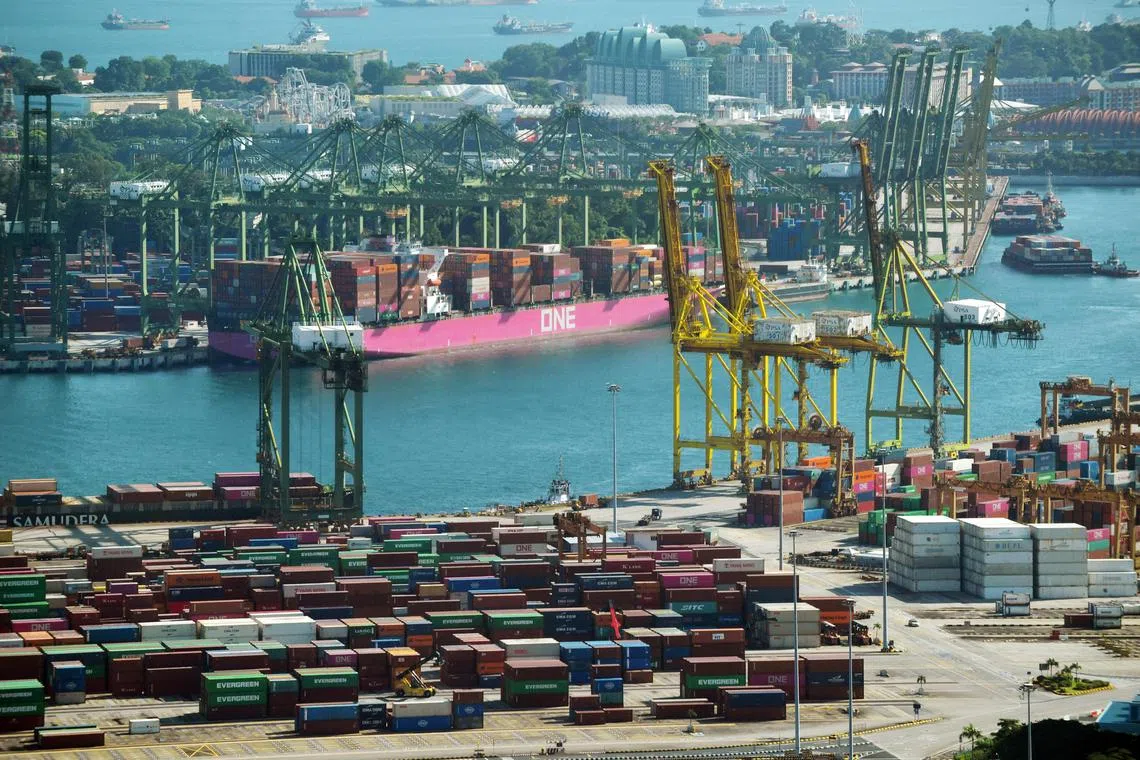Singapore non-oil exports tumble 14.6% in November; economists warn of darkening outlook
Sign up now: Get ST's newsletters delivered to your inbox

The slump in Singapore’s key exports deepened in November on weaker electronics and non-electronics demand.
PHOTO: ST FILE
Follow topic:
SINGAPORE - The slump in Singapore’s key exports has deepened, with weaker demand for electronics prompting economists to warn that the outlook may darken further.
They believe demand will continue to soften in the months ahead, and this will weigh on Singapore’s economy.
Non-oil domestic exports (Nodx) shrank 14.6 per cent year on year in November, from a high base a year earlier, Enterprise Singapore noted. This was the second straight monthly contraction after nearly two years of growth.
The slump reinforced concerns flagged earlier this week by private-sector economists who expect growth in 2023 to be badly hit as export-driven Singapore’s trading partners face a downturn. The economists had lowered their growth forecasts for Singapore by a full percentage point to 1.8 per cent in 2023.
Nodx had expanded 29.2 per cent year on year in November 2021 amid robust global semiconductor demand, with the level then at $4.2 billion, while the monthly average for 2021 stood at $3.7 billion.
The Nodx contraction in November was steeper than Bloomberg’s forecast of a 7.4 per cent drop, and more than double October’s downwardly revised rate of minus 6.1 per cent.
On a month-on-month seasonally adjusted basis, Nodx declined by 9.2 per cent in November, following the previous month’s 4.2 per cent decrease.
The November figure also missed Bloomberg’s forecast of a 3 per cent month-on-month drop, as well as October’s contraction of 3.7 per cent.
Barclays’ senior regional economist Brian Tan said the estimates indicate that the weakness came most notably from a sharp drop in electronic exports and a pullback in shipments of specialised machinery, which had spiked in October.
Electronics shrank by 20.2 per cent year on year in November, following the 9.3 per cent fall the previous month. The decline in November was led by a drop in integrated circuits, disk media products and parts of personal computers.
On a year-on-year basis, non-electronics fell by 12.8 per cent in November, following the 5.1 per cent decrease the previous month. The contraction was led by declines in non-monetary gold, pharmaceuticals and primary chemicals.
In real terms – after adjusting for the effect of price changes – Nodx declined by a heftier 15.7 per cent, owing to both electronics (minus 21.6 per cent) and non-electronics (minus 13.9 per cent).
On a seasonally adjusted basis, Nodx reached $14.3 billion in November, below the previous month’s $15.8 billion and the levels a year earlier. In November 2021, Nodx hit $16.8 billion.
Oxford Economics’ senior Asia economist Alex Holmes said: “The bad news is that worse is to come. We expect external demand to soften further in the first half of 2023 as the United States and euro zone slip into shallow recession.
“While early Chinese reopening presents some upside risk, we doubt any revival in Chinese growth would be enough to fully offset weakening demand from elsewhere.”
Breaking down the numbers by export markets, Nodx to Singapore’s top 10 markets declined as a whole in November.
The Hong Kong market was the worst hit, with shipments sliding 41 per cent, after shrinking 9.1 per cent in October.
It was followed by China, with a contraction of 31.2 per cent, after a 34.4 per cent fall in October.
Exports to the US rose 0.5 per cent, while exports to the European Union grew the most at 7.3 per cent, and exports went up 6.6 per cent in Japan.

With a likely recession in key trading partners, Mr Holmes expects net trade to be a major drag on Singapore’s growth in 2023.
“Tumbling export earnings are also likely to weigh on domestic demand, stalling business investment and employment growth. Against this backdrop, we think the 1.8 per cent median gross domestic product (GDP) growth forecast for 2023 from the recently released Monetary Authority of Singapore (MAS) survey of professional forecasters looks too upbeat,” he said.
Meanwhile, Mr Tan’s base case is that MAS will refrain from further tightening monetary policy in 2023, although the risk of more adjustments remains significant.
“Actual core inflation will likely undershoot the MAS’ projections in the fourth quarter of 2022,” he said, adding that the risk is that the MAS’ estimates could turn out to be too low.
At the same time, Mr Tan noted, the sharp drop in Nodx will “likely reinforce policymakers’ expectations of a visible slowdown in GDP growth in 2023”.


